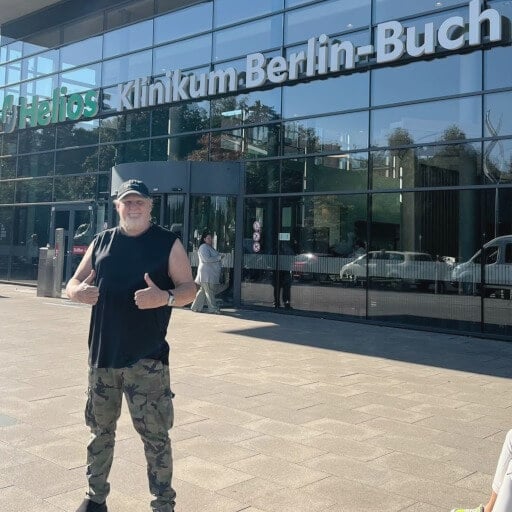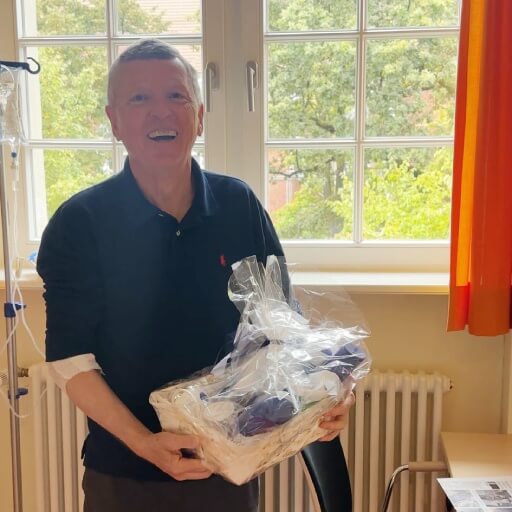Prostate cancer (PC) remains a significant global health concern, ranking as the second most commonly diagnosed cancer among men worldwide. In 2022 alone, approximately 1.47 million new cases were reported [1], accounting for 14.2% of all cancer diagnoses in men [2].
Understanding Prostate Cancer
Prostate cancer varies in its progression. Some tumor types prostate cancer patients may develop are slow-growing and may not require immediate treatment, while others are more aggressive and necessitate prompt intervention.
The disease is typically categorized into four stages [3]:
- Stage I: Cancer is confined within the prostate and is usually undetectable by physical examination.
- Stage II: Tumor is still within the prostate but may be palpable during a digital rectal exam.
- Stage III: Cancer has spread to nearby tissues beyond the prostate.
- Stage IV: Cancer has spread to distant parts of the body, such as the lymph nodes or bones.
A prostate cancer (PCa) diagnosis can be overwhelming. However, it is important to remember that many men continue to lead fulfilling lives post-diagnosis. Advancements in medical treatments, supportive care, and early prostate cancer screening have significantly improved outcomes. With timely detection and appropriate treatment, there is a strong foundation for hope and recovery.
Standard Prostate Cancer Treatments
Surgical removal of the prostate, known as prostatectomy, is a common treatment for localized prostate cancer [4]. Traditional open surgery involves a larger incision, while robotic-assisted techniques, such as the da Vinci system, utilize smaller incisions and offer enhanced precision. Compared to open surgery, robotic-assisted surgery for prostate has been associated with reduced blood loss, shorter hospital stays, and quicker recovery times.
Radiation therapy employs high-energy rays to target and destroy cancer cells. The two main types are external beam radiation therapy (EBRT) and brachytherapy. EBRT directs radiation from outside the body, while brachytherapy involves placing radioactive seeds directly into the prostate. These treatments can be used alone or in combination, depending on the stage and aggressiveness of the cancer.
Chemotherapy uses drugs to kill rapidly dividing cancer cells and is typically reserved for advanced or metastatic prostate cancer. While chemotherapy can have side effects, it may help extend survival and alleviate symptoms in advanced cases.
Innovative Therapies for Prostate Cancer
Lutetium-177 PSMA Therapy for Prostate Cancer
Lutetium-177 PSMA therapy is a radioligand therapy designed for patients with metastatic castration-resistant prostate cancer (mCRPC) [5]. This treatment combines a radioactive isotope, Lutetium-177, with a molecule that specifically targets the prostate-specific membrane antigen (PSMA) found on prostate cancer cells. Upon binding to PSMA-expressing cells, the therapy delivers targeted radiation, effectively destroying cancer cells while minimizing damage to the surrounding healthy tissue. Clinical studies have demonstrated that this treatment approach can significantly improve survival rates and reduce disease progression in patients who have exhausted other cancer treatment options.
Immunotherapy: Dendritic Cell Therapy for Prostate Cancer
Dendritic cell therapy represents a groundbreaking advancement in prostate cancer treatment that utilizes the body's own immune system to combat cancer cells. This innovative approach involves extracting a patient's dendritic cells, exposing them to prostate cancer antigens in a laboratory setting, and then reintroducing them into the patient's body. The goal is to stimulate an immune response, enabling T cells to recognize and attack prostate cancer cells. The significance of dendritic cells in immunotherapy was emphasized when Canadian immunologist Ralph Marvin Steinman was awarded the 2011 Nobel Prize in Physiology or Medicine for his discovery of these cells and their role in adaptive immunity [6]. Today, dendritic cell therapy is available in specialized centers worldwide, including Germany, where it serves as an effective addition to standard treatment protocols for prostate cancer.
In the interview below, Professor Frank Gansauge, a leading authority in immunotherapy, explains the role of dendritic cells in directing the body's immune response against cancer. He also discusses the integration of dendritic cell therapy with conventional treatments, such as chemotherapy and radiation therapy (RT).
Professor Frank Gansauge on Dendritic Cell Therapy and Its Role in Cancer Treatment
Targeted Therapies for Prostate Cancer
Targeted therapies are precision medicines designed to interfere with the specific molecules or genetic mutations that drive cancer growth. In prostate cancer, these therapies are particularly beneficial for advanced or castration-resistant cases. For example, PARP inhibitors are effective in patients with BRCA1/2 or ATM gene mutations, disrupting cancer cell DNA repair mechanisms and leading to their death. These treatments often result in fewer side effects compared to traditional chemotherapy, as they spare healthy cells. Depending on the patient's specific cancer profile, targeted therapies can be used alone or in combination with other treatments.
Transurethral Resection of the Prostate (TURP) in Prostate Cancer
Transurethral resection of the prostate (TURP) is a surgical procedure primarily used to alleviate urinary symptoms caused by prostate enlargement, including cases where the enlargement is due to prostate cancer. During the procedure, a surgeon removes parts of the prostate tissue obstructing urine flow through the urethra. While TURP does not cure prostate cancer, it can significantly improve quality of life by relieving symptoms such as frequent urination, urgency, and weak stream. It is considered a palliative treatment that is especially beneficial for patients with advanced prostate cancer experiencing urinary obstruction.
Brachytherapy (BT) in Prostate Cancer
Brachytherapy, or internal radiation therapy, involves implanting radioactive seeds directly into the prostate gland [7]. This method delivers high doses of radiation to the tumor while minimizing exposure to surrounding healthy tissues. There are two main types: low-dose-rate (LDR) brachytherapy, in which the seeds remain permanently and emit radiation over several months, and high-dose-rate (HDR) brachytherapy, which involves temporary placement of radioactive material for a short duration. Brachytherapy is often used for localized prostate cancer and can be combined with external beam radiation therapy for more aggressive cases.
Photodynamic Therapy (PDT) in Prostate Cancer
Photodynamic therapy (PDT) is an emerging treatment that uses light-sensitive drugs activated by specific wavelengths of light to destroy cancer cells. Once the photosensitizing agent is administered and absorbed by the cancer cells, the targeted area is exposed to light, triggering a reaction that kills the malignant cells while sparing most healthy tissue. Currently, PDT for prostate cancer is primarily available in Western countries, as researchers continue to evaluate its efficacy and optimal application modalities. However, studies show that this treatment method preserves urinary continence and erectile function in 100% and 67% of patients, respectively.
Interventional Radiology (IR) in Prostate Cancer
Interventional radiology (IR) offers minimally invasive, image-guided treatments for prostate cancer, providing alternatives to traditional surgery and radiation therapy. These therapies focus on targeting cancerous tissue while preserving healthy structures, aiming to reduce side effects and improve recovery times.
Thermal Ablation: Thermal ablation techniques, such as radiofrequency ablation (RFA) and microwave ablation (MWA), use heat to destroy cancer cells. In RFA, electrical currents generate heat to ablate the tumor, while MWA uses electromagnetic waves for the same purpose. These methods are particularly useful for treating localized prostate tumors and are guided by imaging technologies to ensure precision.
Cryoablation: Involves freezing prostate cancer cells using cryoprobes inserted into the tumor. The extreme cold causes ice crystals to form inside the cells, leading to cell death. This technique is effective for patients who are not candidates for surgery and can be used as a primary treatment or after other therapies have failed. Cryoablation is typically performed under image guidance to target the tumor accurately. Research shows that this treatment helps preserve urinary continence in 96-100% of patients and erectile function in 71-90%.
Irreversible Electroporation (IRE): Is a non-thermal ablation method that uses electrical pulses to create permanent pores in cancer cell membranes, leading to cell death. This technique spares surrounding tissues, such as nerves and blood vessels, making it suitable for tumors located near critical structures. IRE shows promise as a focal therapy for prostate cancer, preserving continence in 100% of patients and sexual potency in 95%.
Electrochemotherapy (ECT): Combines chemotherapy with electrical pulses to enhance drug uptake by cancer cells. The electrical pulses temporarily increase cell membrane permeability, allowing the chemotherapeutic agents to enter the cells more effectively. Currently, the application of ECT in prostate cancer is considered promising, as it shows positive results in prostate cancer patients.

Transarterial Chemoembolization (TACE): Delivers chemotherapy directly to the prostate tumor through the arteries, followed by embolic agents that block the blood supply, trapping the drug in the tumor and causing ischemia. This method has shown potential for treating advanced prostate cancer. It enables high local drug concentrations while minimizing systemic side effects, making it especially beneficial for patients who are not candidates for surgery or systemic chemotherapy. TACE can also be combined with other therapies, such as immunotherapy or radiation therapy, to enhance overall treatment efficacy.
Prof. Kovács: Why TACE Doubled Cancer Survival – What Patients Need to Know
Comparative Table: Prostate Cancer Treatments Abroad
| Therapy Type | 2-Year Survival Rate | Response Rate | Duration | Side Effects |
|---|---|---|---|---|
| Standard Treatment | ~25% for advanced cancer | Less than 10% | Several cycles | Severe (nausea, fatigue, hair loss, immunosuppression, skin irritation) |
| Innovative Methods | ~60% for advanced cancer | 45-65% | Up to 4 sessions | Mild (localized discomfort) |
* Booking Health data
Medical Procedures Costs Around the World for Prostate Cancer
| Treatment Method | GERMANY* | Great Britain | USA |
|---|---|---|---|
| Standard Treatment | €80,000 - €150,000 full course | €90,000 - €165,000 full course | €100,000 - €180,000 full course |
| Innovative Methods | €25,000 - €60,000 full course | €70,000 - €120,000 full course | €100,000 - €150,000 full course |
* Prices may vary depending on the course of treatment and tumor characteristics.
Real Stories: Successful Prostate Cancer Treatments
Patients from around the world have shared their positive experiences with Booking Health, highlighting the organization's role in facilitating their medical journeys abroad.
Gary Philoctete's Experience at the Hospital Neuwerk Moenchengladbach
After receiving a prostate cancer diagnosis, Gary Philoctete from the United States sought a treatment path that combined advanced medical care with compassionate support. Upon discovering Booking Health, he reached out to their team, who promptly assisted him in coordinating his treatment at Hospital Neuwerk Moenchengladbach in Germany. From the initial consultation to the completion of his therapy, Gary and his family felt consistently supported and well-informed. The Booking Health team managed all logistical aspects, including medical appointments, travel arrangements, and accommodations, allowing Gary to focus entirely on his recovery. Their professionalism and empathy not only made the process more efficient but also offered emotional comfort during a particularly trying time.
Modern Cancer Treatment: Patient Journeys with Booking Health
A Medical Journey: Every Step of the Way With Booking Health
Finding the best treatment strategy for your clinical situation is a challenging task. Being already exhausted from multiple treatment sessions, having consulted numerous specialists, and having tried various therapeutic interventions, you may be lost in all the information given by the doctors. In such a situation, it is easy to choose a first-hand option or to follow standardized therapeutic protocols with a long list of adverse effects instead of selecting highly-specialized innovative treatment options.
To make an informed choice and get a personalized cancer management plan, which will be tailored to your specific clinical situation, consult medical experts at Booking Health. Being at the forefront of offering the latest medical innovations for already 12 years, Booking Health possesses solid expertise in creating complex cancer management programs in each individual case. As a reputable company, Booking Health offers personalized prostate cancer treatment plans with direct clinic booking and full support at every stage, from organizational processes to assistance during treatment. We provide:
- Assessment and analysis of medical reports
- Development of the medical care program
- Selection of a suitable treatment location
- Preparation of medical documents and forwarding to a suitable clinic
- Preparatory consultations with clinicians for the development of medical care programs
- Expert advice during the hospital stay
- Follow-up care after the patient returns to their native country after completing the medical care program
- Taking care of formalities as part of the preparation for the medical care program
- Coordination and organization of the patient's stay in a foreign country
- Assistance with visas and tickets
- A personal coordinator and interpreter with 24/7 support
- Transparent budgeting with no hidden costs
Health is an invaluable aspect of our lives. Delegating management of something so fragile yet precious should be done only to experts with proven experience and a reputation. Booking Health is a trustworthy partner who assists you on the way of pursuing stronger health and a better quality of life. Contact our medical consultant to learn more about the possibilities of personalized treatment with innovative methods for prostate cancer with leading specialists in this field.
Frequently Asked Questions of Our Patients About Prostate Cancer Treatment Abroad
Send request for treatmentGermany is renowned for its advanced technologies and specialized prostate cancer treatments. The USA and the UK also offer high-quality care, with the USA known for modern research and the UK for its excellent healthcare system.
Consider factors like the country's medical expertise, availability of advanced treatments, cost, and language barriers. Germany often provides a balance of innovation and affordability.
Yes, many countries offer advanced treatments such as robotic-assisted surgery, immunotherapy, and targeted radionuclide therapies like Lutetium-177 PSMA therapy, which may not be widely available elsewhere.
The duration varies: surgery typically requires a 2-3 week stay, while radiotherapy may extend up to one month. Your medical coordinator will provide a tailored schedule.
You will need your medical history, recent imaging scans, pathology reports, and possibly additional blood tests. Some clinics may request further diagnostics upon arrival.
Absolutely. Many international hospitals offer remote consultations to confirm diagnoses and discuss treatment options before you commit to traveling.
Yes, with proper planning and medical clearance. Even amid travel restrictions, top hospitals in European countries ensure safe environments for international patients.
The early symptoms of prostate cancer may include frequent urination (especially at night), weak or interrupted urine flow, difficulty starting urination, blood in urine or semen, and pelvic discomfort. Many cases are asymptomatic in early stages, making screening important.
The prostate cancer treatment cost in Germany varies by method and clinic. Treatment with standard methods typically ranges from €80,000 to €150,000 for the full course, while innovative procedures may cost between €25,000 and €60,000.
The latest treatment for prostate cancer in Germany includes Lutetium-177 PSMA radionuclide therapy, advanced hormone therapy, robotic-assisted surgery (Da Vinci), and precision radiation techniques. These options improve outcomes and reduce side effects.
Yes, prostate cancer immunotherapy – including dendritic cell therapy and checkpoint inhibitors – is being used in advanced or recurrent cases. It may enhance the immune system's ability to fight cancer and is often combined with conventional treatments.
Yes, non-surgical treatment for prostate cancer includes active surveillance, radiation therapy, hormone therapy, brachytherapy, and immunotherapy. These options are suitable for early-stage patients or those not eligible for surgery.
The prostate cancer treatment success rate in Germany is high, with 5-year survival exceeding 90% for localized disease. Success depends on the stage, chosen therapy, and overall patient health, but outcomes are among the best in Europe.
Yes, prostate cancer treatment in Germany for international patients does not require a local referral. Medical travel coordinators assist with documentation, scheduling, interpretation, and visa support to simplify the process.
Lifestyle changes during prostate cancer treatment may include adopting a plant-rich diet, reducing saturated fats, exercising regularly, managing stress, quitting smoking, and limiting alcohol – all of which support recovery and long-term wellness.
For advanced or stage 4 prostate cancer, the 2-year survival rate with standard options (e. G. , hormone therapy, chemotherapy, or radiotherapy) is around 25%. In turn, with innovative treatments (e. G. , lutetium-177 psma therapy, dendritic cell immunotherapy, transarterial chemoembolization (tace), or ablation), the rate can reach approximately 60%.
What are the typical response rates for advanced prostate cancer with standard versus innovative therapies?
In advanced prostate cancer, standard systemic therapy often achieves a response rate below 10%. However, innovative treatments (e. G. , psma-targeted radionuclide therapy, dendritic cell therapy, tace, or focal ablation) may offer 45-65% response rates.
For advanced prostate cancer, standard treatments typically involve multiple chemotherapy or hormone-therapy cycles over several months. In contrast, innovative methods (e. G. , tace, cryoablation, or dendritic cell therapy) are usually completed in up to four sessions.
What side effects are common during advanced prostate cancer treatment, and how do they differ between standard and innovative methods?
Standard prostate cancer treatments can cause major side effects such as fatigue, nausea, hair loss, and immune suppression. Innovative options (e. G. , lutetium-177 psma therapy, dendritic cell immunotherapy, or thermal ablation) tend to cause only mild, localized effects like temporary discomfort or low-grade fever.
Choose treatment abroad and you will for sure get the best results!
Authors:
This article was edited by medical experts, board-certified doctors Dr. Nadezhda Ivanisova, and Dr. Bohdan Mykhalniuk. For the treatment of the conditions referred to in the article, you must consult a doctor; the information in the article is not intended for self-medication!
Our editorial policy, which details our commitment to accuracy and transparency, is available here. Click this link to review our policies.
Sources:
[1] Research Gate. International Variation in Prostate Cancer Incidence and Mortality Rates. https://www.researchgate.net/publication/221713090_International_Variation_in_Prostate_Cancer_Incidence_and_Mortality_Rates
[2] Pharmaceuticals. Revolutionizing Prostate Cancer Detection: The Role of Approved PSMA-PET Imaging Agents. https://www.mdpi.com/1424-8247/18/6/906
[3] American Cancer Society. Prostate Cancer Stages. https://www.cancer.org/cancer/types/prostate-cancer/detection-diagnosis-staging/staging.html
[4] Prostate Cancer UK. Surgery: radical prostatectomy. https://prostatecanceruk.org/prostate-information-and-support/treatments/surgery
[5] The New England Journal of Medicine. Lutetium-177–PSMA-617 for Metastatic Castration-Resistant Prostate Cancer. https://www.nejm.org/doi/full/10.1056/NEJMoa2107322
[6] PubMed. The 2011 Nobel Prize in physiology or medicine. https://pubmed.ncbi.nlm.nih.gov/22053831/
[7] Cancer Research UK. Brachytherapy for prostate cancer. https://www.cancerresearchuk.org/about-cancer/prostate-cancer/treatment/radiotherapy/brachytherapy
Read:
Article menu:
- Understanding Prostate Cancer
- Standard Prostate Cancer Treatments
- Innovative Therapies for Prostate Cancer
- Comparative Table: Prostate Cancer Treatments Abroad
- Real Stories: Successful Prostate Cancer Treatments
- A Medical Journey: Every Step of the Way With Booking Health
- Frequently Asked Questions of Our Patients About Prostate Cancer Treatment Abroad
Don't know where to start?
Contact Booking Health











